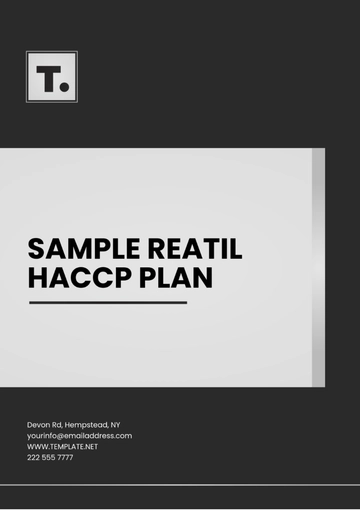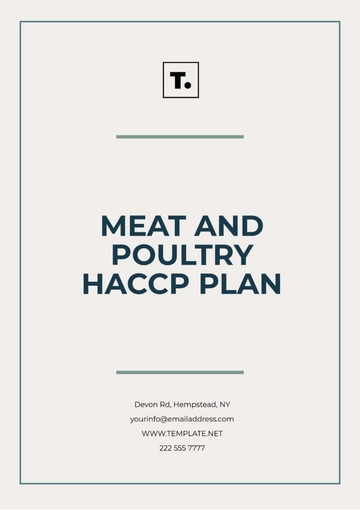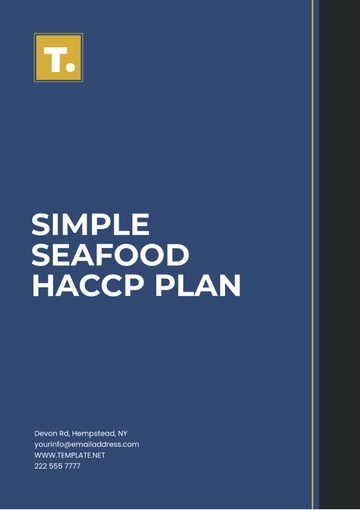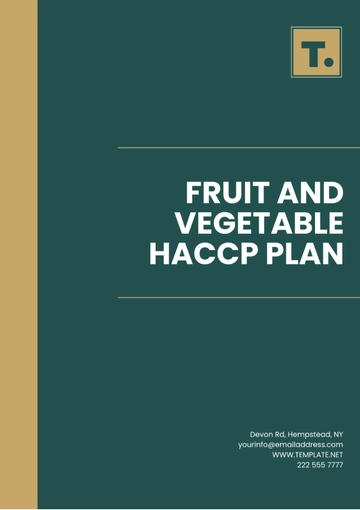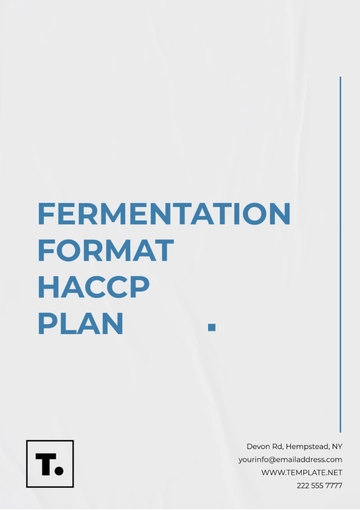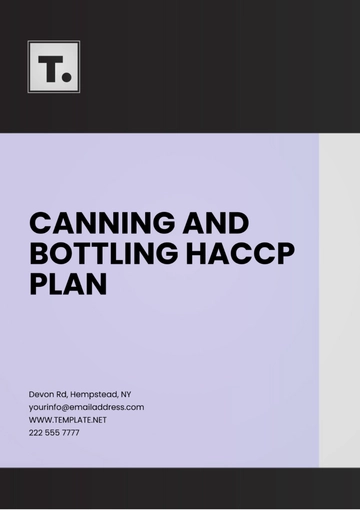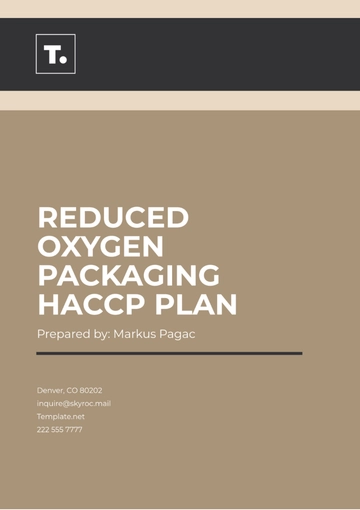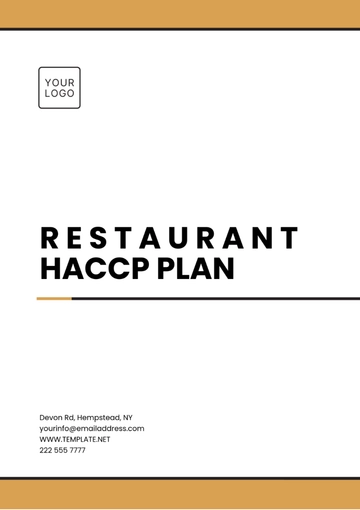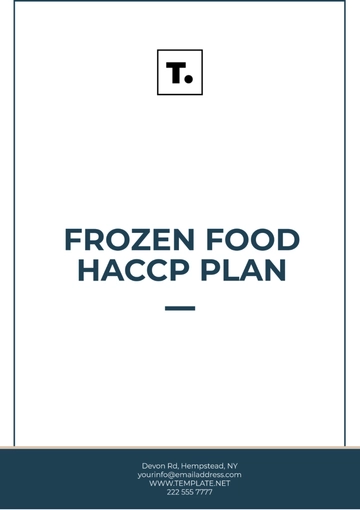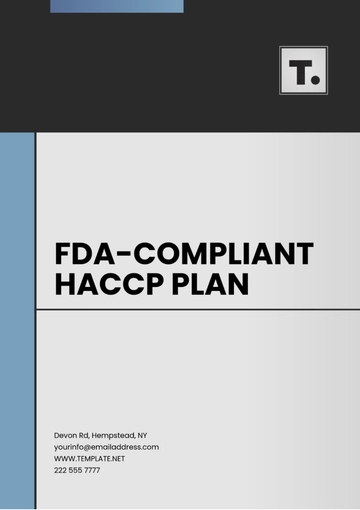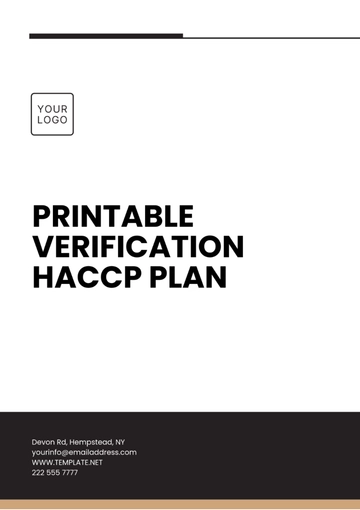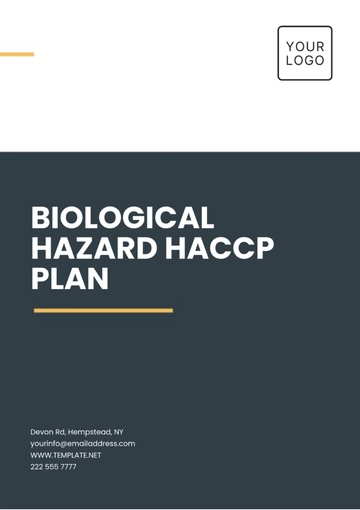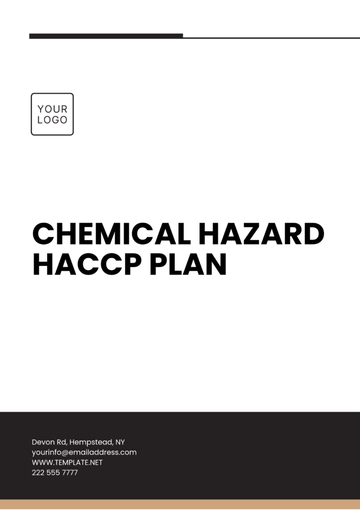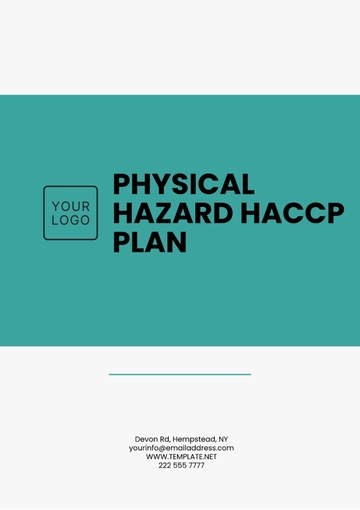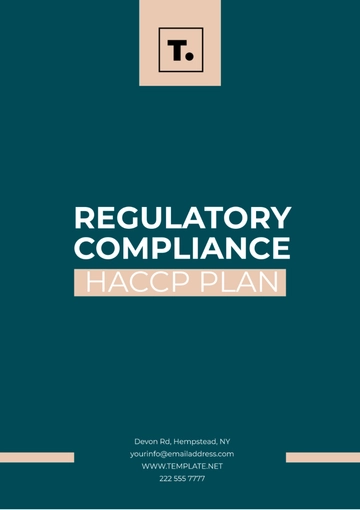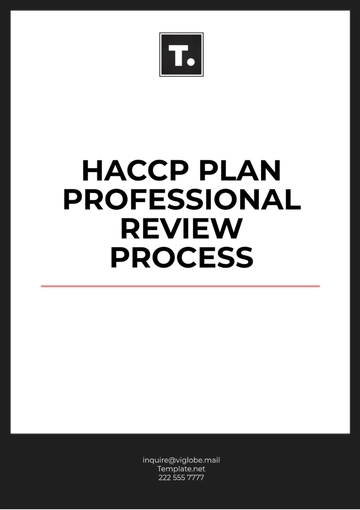Free Simple Seafood HACCP Plan
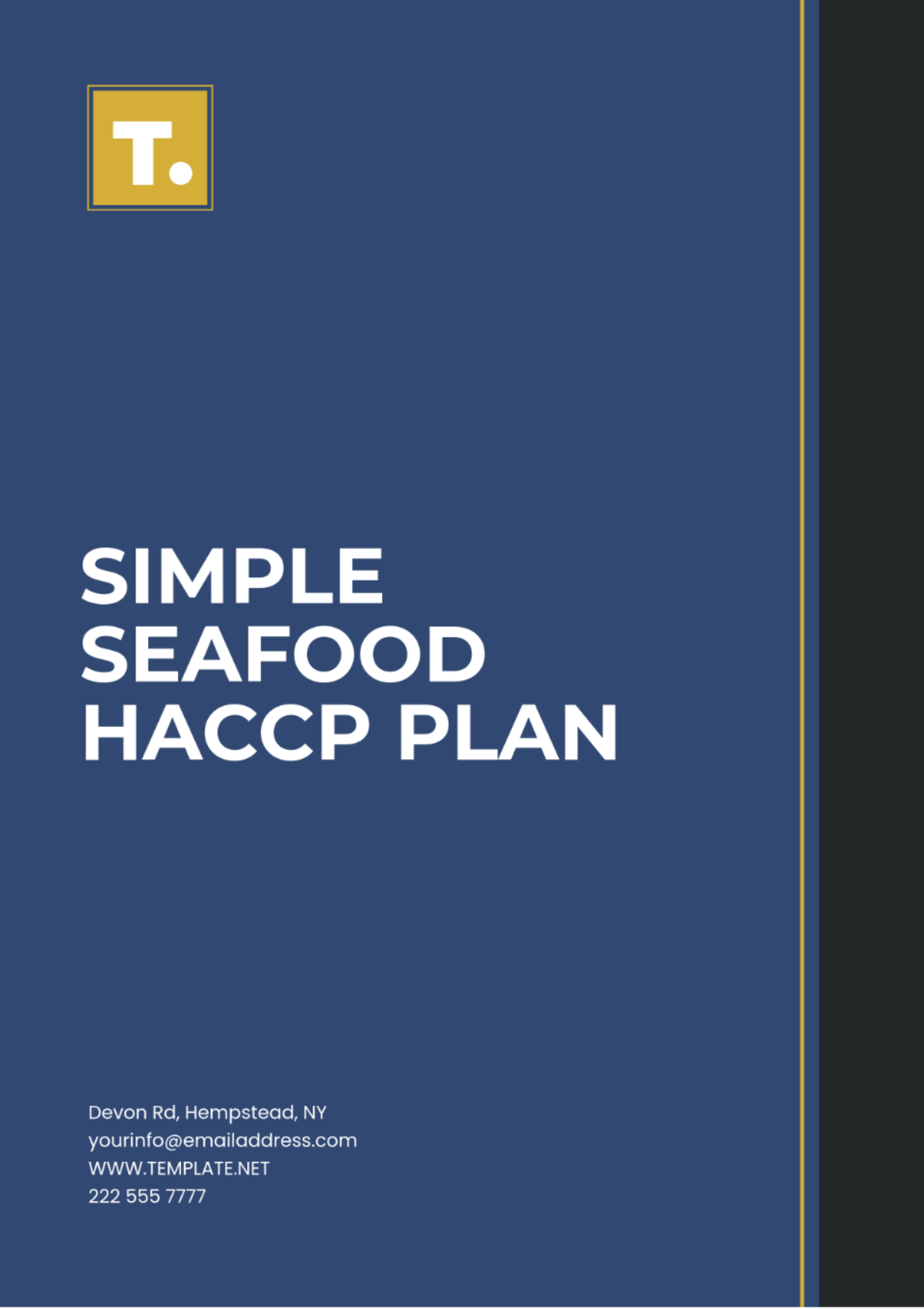
Company Name: [YOUR COMPANY NAME]
Location: 123 Oceanview Drive, Coastal City, CA 94000
Plan Developed By: [YOUR NAME]
Date: January 15, 2060
I. Product Description
Product: Fresh Shrimp
Packaging: Vacuum-sealed plastic bags
Intended Use: Ready-to-eat after cooking
Shelf Life: 7 days refrigerated; 6 months frozen
Distribution: Refrigerated trucks to local grocery stores and restaurants
II. Hazard Analysis
Processing Step | Potential Hazards | Control Measures |
|---|---|---|
Receiving Raw Seafood | Biological (bacteria, parasites) | Inspect temperature at receiving; supplier certification required |
Storing Seafood | Physical (metal fragments) | Maintain proper storage conditions; regular checks on storage areas |
Thawing | Biological (pathogen growth) | Keep temperature below 5°C; monitor thawing time |
Processing (e.g., cutting, filleting) | Chemical (cleaning agents) | Regular sanitation checks; minimize the use of chemicals in proximity to seafood |
Packaging | Biological (cross-contamination) | Use clean, sanitized packaging equipment; employee training on hygiene |
III. Critical Control Points (CCPs)
CCP | Hazard | Critical Limit | Monitoring | Corrective Actions |
|---|---|---|---|---|
Receiving | Pathogen growth due to temperature | < 5°C (41°F) during transport | Inspect truck temperature on delivery; record in the logbook | Reject shipment if above the critical limit |
Thawing | Bacterial growth | Seafood temperature < 5°C | Monitor with a thermometer every 2 hours; maintain logs | Discard seafood if temperature exceeds 5°C |
Cooking (if applicable) | Incomplete cooking | Internal temperature ≥ 63°C (145°F) | Monitor with food thermometer at intervals; keep records | Re-cook until proper internal temp is reached |
IV. Monitoring Procedures
Receiving: When the delivery truck arrives, it's crucial to measure and confirm the temperature inside the vehicle, then accurately document and record this information in the receiving log for future reference and verification.
Thawing: While thawing seafood, it is crucial to monitor its temperature every two hours using correctly calibrated thermometers to guarantee precise measurements.
Cooking (if applicable): Check seafood's internal temperature with a calibrated thermometer, recording temperatures every 30 minutes.
V. Corrective Actions
If a shipment arrives with seafood above the critical limit (e.g., higher than 5°C), reject the shipment, notify the supplier, and document the incident.
If the seafood temperature during thawing exceeds the critical limit, discard the affected batch to prevent contamination and review thawing procedures with staff.
If the cooking temperature is insufficient, continue cooking until the internal temperature is above the required limit, and retrain staff on cooking procedures.
VI. Verification Procedures
Thermometers used for monitoring critical control points should undergo a regular calibration process every six months.
Annual review of the HACCP plan to ensure compliance with updated regulations, with the next review scheduled for January 15, 2061.
Conducting inspections quarterly of the monitoring logs and records of corrective actions to ensure that they comply.
VII. Recordkeeping
As part of your Hazard Analysis and Critical Control Points (HACCP) plan, it is essential that you keep and organize a comprehensive collection of the following documents:
Receiving Log: Includes temperature checks, supplier certifications, and dates (e.g., logs dated from January 15, 2060).
Thawing Temperature Monitoring Log: Document every check made during thawing, including time and temperature.
Corrective Actions Record: Document all incidents of deviations from critical limits and actions taken.
Verification Records: Include thermometer calibration records, inspection results, and compliance checks.
- 100% Customizable, free editor
- Access 1 Million+ Templates, photo’s & graphics
- Download or share as a template
- Click and replace photos, graphics, text, backgrounds
- Resize, crop, AI write & more
- Access advanced editor
Ensure food safety compliance in seafood handling with our Simple Seafood HACCP Plan Template. Fully editable and customizable, this template from Template.net helps streamline your hazard analysis and critical control points. It's specifically designed for seafood processors, making it easy to implement safety standards. Editable in our Ai Editor Tool, you can tailor it to suit specific regulatory needs
You may also like
- Finance Plan
- Construction Plan
- Sales Plan
- Development Plan
- Career Plan
- Budget Plan
- HR Plan
- Education Plan
- Transition Plan
- Work Plan
- Training Plan
- Communication Plan
- Operation Plan
- Health And Safety Plan
- Strategy Plan
- Professional Development Plan
- Advertising Plan
- Risk Management Plan
- Restaurant Plan
- School Plan
- Nursing Home Patient Care Plan
- Nursing Care Plan
- Plan Event
- Startup Plan
- Social Media Plan
- Staffing Plan
- Annual Plan
- Content Plan
- Payment Plan
- Implementation Plan
- Hotel Plan
- Workout Plan
- Accounting Plan
- Campaign Plan
- Essay Plan
- 30 60 90 Day Plan
- Research Plan
- Recruitment Plan
- 90 Day Plan
- Quarterly Plan
- Emergency Plan
- 5 Year Plan
- Gym Plan
- Personal Plan
- IT and Software Plan
- Treatment Plan
- Real Estate Plan
- Law Firm Plan
- Healthcare Plan
- Improvement Plan
- Media Plan
- 5 Year Business Plan
- Learning Plan
- Marketing Campaign Plan
- Travel Agency Plan
- Cleaning Services Plan
- Interior Design Plan
- Performance Plan
- PR Plan
- Birth Plan
- Life Plan
- SEO Plan
- Disaster Recovery Plan
- Continuity Plan
- Launch Plan
- Legal Plan
- Behavior Plan
- Performance Improvement Plan
- Salon Plan
- Security Plan
- Security Management Plan
- Employee Development Plan
- Quality Plan
- Service Improvement Plan
- Growth Plan
- Incident Response Plan
- Basketball Plan
- Emergency Action Plan
- Product Launch Plan
- Spa Plan
- Employee Training Plan
- Data Analysis Plan
- Employee Action Plan
- Territory Plan
- Audit Plan
- Classroom Plan
- Activity Plan
- Parenting Plan
- Care Plan
- Project Execution Plan
- Exercise Plan
- Internship Plan
- Software Development Plan
- Continuous Improvement Plan
- Leave Plan
- 90 Day Sales Plan
- Advertising Agency Plan
- Employee Transition Plan
- Smart Action Plan
- Workplace Safety Plan
- Behavior Change Plan
- Contingency Plan
- Continuity of Operations Plan
- Health Plan
- Quality Control Plan
- Self Plan
- Sports Development Plan
- Change Management Plan
- Ecommerce Plan
- Personal Financial Plan
- Process Improvement Plan
- 30-60-90 Day Sales Plan
- Crisis Management Plan
- Engagement Plan
- Execution Plan
- Pandemic Plan
- Quality Assurance Plan
- Service Continuity Plan
- Agile Project Plan
- Fundraising Plan
- Job Transition Plan
- Asset Maintenance Plan
- Maintenance Plan
- Software Test Plan
- Staff Training and Development Plan
- 3 Year Plan
- Brand Activation Plan
- Release Plan
- Resource Plan
- Risk Mitigation Plan
- Teacher Plan
- 30 60 90 Day Plan for New Manager
- Food Safety Plan
- Food Truck Plan
- Hiring Plan
- Quality Management Plan
- Wellness Plan
- Behavior Intervention Plan
- Bonus Plan
- Investment Plan
- Maternity Leave Plan
- Pandemic Response Plan
- Succession Planning
- Coaching Plan
- Configuration Management Plan
- Remote Work Plan
- Self Care Plan
- Teaching Plan
- 100-Day Plan
- HACCP Plan
- Student Plan
- Sustainability Plan
- 30 60 90 Day Plan for Interview
- Access Plan
- Site Specific Safety Plan


